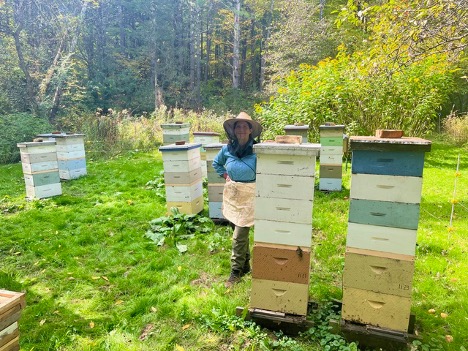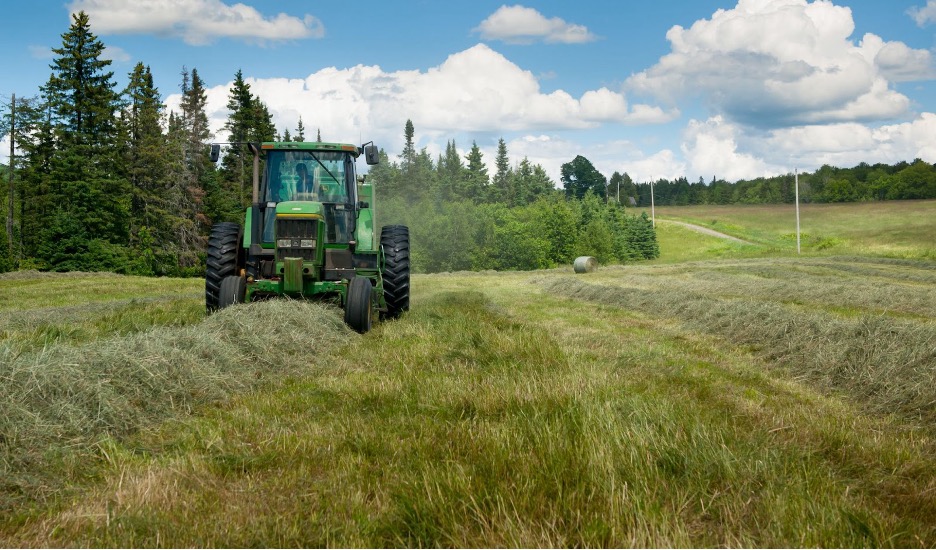As competition from the West displaced the once prosperous sheep industry, the number of dairy farms in the state surged to nearly 35,000 in only 30 years –70 times the number of dairies that remain today.
Vermont's climate and landscape created ideal conditions for dairy to flourish, enabling another important agricultural industry to mirror its success – beekeeping.
Along with bolstering the state’s economy, dairy helped preserve the Champlain Valley’s agricultural paradise and provided abundant forage for managed honey bees and their beekeepers.
With over 300,000 acres of pasture, forage, and hay crop in the state today, grass-fed dairy farms continue to generate a feast of clover, alsike, and alfalfa that feeds honey bees.
In turn, beekeepers provide the crucial pollination services to crops like alfalfa, that support annual crop regrowth to feed cattle.
These producers lie at the heart of our economic and cultural identity, earning Vermont its title as the Land of Milk and Honey.
To further explore how Vermont’s landscape is reflected in the flavors of its products, we spoke with Maddie Calderwood, farm coordinator at Jasper Hill Farm, and Bianca Braman, co-owner of Vermont Bees LLC.
Vermont Bees LLC is in the northern Champlain Valley. Their operation is made up of nearly two dozen bee yards –collections of honey bee hives situated on field margins, open meadows, and neighbors’ backyards.
Together, co-owners Bianca Braman, Adam Collins, and Bruce Collins, specialize in producing queen bees, starter colonies, and raw honey.
Inside the honey house, Braman can be found combing through honey frames, reaping the culmination of a season’s hard work. Her raw honey is pure and unprocessed, retaining its natural properties, which creates the complex flavors and textures that are often lost to commercial processing.
 Bianca Braman inspecting a colony in one of her bee yards.
Bianca Braman inspecting a colony in one of her bee yards.
Honey serves as a prime example of how the flavors of Vermont's agricultural products are deeply linked to the changing seasons.
“Seasonality is paramount to the flavor and texture of honey,” Braman explained.
Each season introduces different nectar-producing plants, such as dandelion, honeysuckle, sumac, clover, basswood, and goldenrod.
And the honeys’ flavors reflect the plants the bees visit throughout the season, offering a wide range of sweet, floral, earthy, or nutty notes that are unique to the place of origin. –“The combination of nectars from our local flora creates a stunning blend,” Braman said.
Some of which have even been awarded ‘World’s Best Tasting Honey’.
To the east, Jasper Hill Farm is nestled in the valleys of Vermont’s Northeast Kingdom on rolling pastures that support their single herd of grass-fed dairy cows.
Milk produced on their farm gets turned into four distinct raw cheeses that are ripened in their on-site aging cellars.

The aging cellars at Jasper Hill Farm.
By producing value-added products, the farm generates a reliable and fair return on their high-quality milk.
That way, the farm can focus on building healthy soils and preserving the working landscape.
Seasonality is captured in the diverse pastures and hay fields that create nutritious feed for the cows and play a key role in shaping the flavor development of the cheeses.

Baling hay to feed the cows year round at Jasper Hill Farm.
A blend of dry hay that is baled during the summer months is fed to the cows year-round, resulting in a complex, but consistent milk product for the cheesemakers, Calderwood said.
“The smell of a bale of dry hay is the smell of summer,” she noted.
The unique assemblage of natural microbiota in the milk are preserved in the making of their raw cheeses, delivering an authentic and internationally awarded ‘Taste of Place.’
It’s no surprise that Vermont’s cheese and honey pair beautifully, they embody the state’s diverse landscape and common history, reinforcing its identity as the Land of Milk and Honey.
When we asked what this phrase means to her, Braman described it as a beautiful expression of prosperity.
“Vermont offers a generous four seasons and plenty of water to nourish the landscape. Our soils are fertile and filled with wild blooms and lush grasses.”
“Milk and honey keep us healthy through dark times, giving sweetness and light,” she added.
Calderwood echoed this sentiment, emphasizing that “our patchwork of fields and forests is ideal for grazing cows and producing hay, while also creating habitats for a wide variety of plants and animals.”
“The biodiversity of our agricultural landscape—essential for our resilience and sustainability—is best captured in Vermont honey and cheeses.”
Ready to experience this for yourself? Jasper Hill Farm has partnered with local Vermont honey producers to showcase featured pairings for a taste of Vermont's finest.
We recommend Bayley Hazen Blue alongside Lemon Fair Honeyworks’ Summer Harvest honeycomb –a delightful addition to any cheese board.
With its rich, fudge-like texture and hints of sweet grass, toasted-nut, and anise spice, Bayley Hazen Blue perfectly complements the mild, delicate sweetness of this summer clover, linden, and basswood blend.

Baylen Hazen Blue cheese paired with Lemon Fair Honeyworks summer harvest.
In memory of Bill Mares, a cherished figure in the Vermont beekeeping community, whose efforts to educate and advocate for pollinator health continue to inspire those in his footsteps. This feature article is adapted from The Land of Milk and Honey by Bill Mares and Ross Conrad.
About the author:
Sydney Miller is the Lead Research Technician at the Vermont Bee Lab (UVM) and Agricultural Liaison for the Vermont Beekeeper’s Association. She helps to protect managed and wild pollinators through research, education, and outreach efforts at the Vermont Bee Lab, and is passionate about engaging diverse agricultural stakeholders to support the Vermont beekeeping industry.